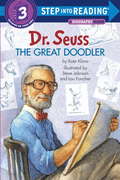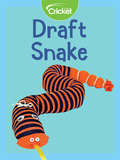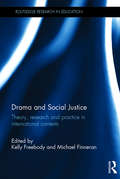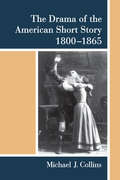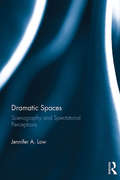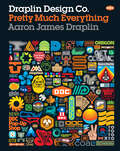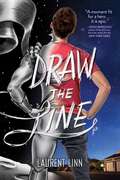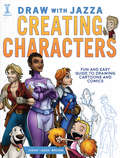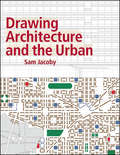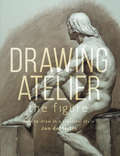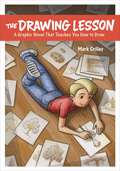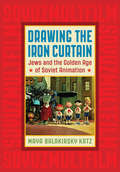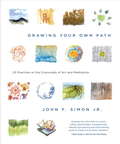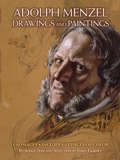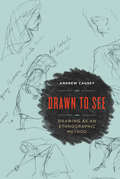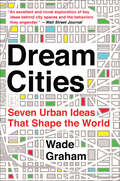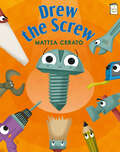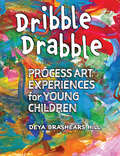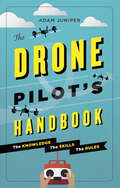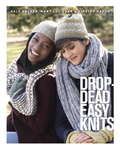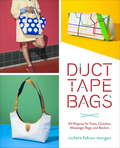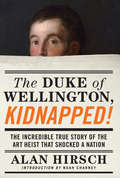- Table View
- List View
Dr. Seuss: The Great Doodler (Step into Reading)
by Kate KlimoA Step 3 Biography Reader about Theodor Geisel and his transformation from a doodler into the beloved Dr. Seuss. Little Ted Geisel always had a sketchpad and pencil in hand. He was a Boy Scout with a penchant for creating zany creatures. He grew up with a love of books and words from his mother, and his inventor father spawned a wildly imaginative and perfectionist side. It's no wonder that these qualities led to the beloved work of Dr. Seuss, the Great Doodler. Follow his career as an ad man, political cartoonist, creator of forty-five indelible children's books, and Pulitzer Prize winner. Not bad for a lifelong doodler! Includes fun facts and several of Dr. Seuss's original sketches and artwork! Step 3 Readers feature engaging characters in easy-to-follow plots about popular topics. For children who are ready to read on their own.From the Trade Paperback edition.
Draft Snake
by Liz HuyckMake a snake that is fun to create and keeps out the cold by a drafty door.
Drama and Social Justice: Theory, research and practice in international contexts (Routledge Research in Education)
by Kelly Freebody Michael Finneran"This text offers a cohesive framework for exploring social justice through drama and drama from a social justice perspective. Research based examples of practice from a range of international contexts link theory and practice. Connecting chapters raise key critical questions in an engaging dialogue format. An important addition to the literature on social justice education." - Lee Anne Bell, author Storytelling for Social Justice (2010) and co-editor of Teaching for Diversity and Social Justice (Routledge, 2007) Much has been written within the tradition of drama education and applied theatre around the premise that drama can be a force for change within both individual lives and society more broadly. However, little has been published in terms of charting the nature of this relationship. By combining theoretical, historical and practical perspectives, this book unpacks and explores drama’s intrinsically entwined relationship with society more comprehensively and critically.Chapters gather together and develop a range of theoretical understandings of social justice in applied drama in the first part of the book, which are then used to frame and inform more focused discussions of drama research and practice in the second. Contributors move beyond practical understandings of drama for empowerment or development in order to engage with the philosophy of praxis – the interconnected and symbiotic nature of theory derived from practice, and practice derived from theory. Including concrete examples from current research and practice in the field, the book opens up a conversation on and counter-narrative to perceptions of the nature and impact of applied theatre and drama education on social justice.Drama and Social Justice will be key reading for postgraduate students, academics, researchers and field-based practitioners in the areas of applied drama and theatre, education and youth work, and social justice and the social sciences.
The Drama of the American Short Story, 1800-1865
by Michael J. CollinsThe Drama of the American Short Story, 1800-1865 argues that to truly understand the short story form, one must look at how it was shaped by the lively, chaotic, and deeply politicized world of 19th-century transatlantic theater and performance culture. By resurrecting long-neglected theatrical influences on representative works of short fiction, Michael J. Collins demonstrates that it was the unruly culture of the stage that first energized this most significant of American art forms. Whether it was Washington Irving's first job as theater critic, Melville's politically controversial love of British drama, Alcott's thwarted dreams of stage stardom, Poe and Lippard's dramatizations of peculiarly bloodthirsty fraternity hazings, or Hawthorne's fascination with automata, theater was a key imaginative site for the major pioneers of the American short story. The book shows how perspectives from theater studies, anthropology, and performance studies can enrich readings of the short-story form. Moving beyond arbitrary distinctions between performance and text, it suggests that this literature had a social life and was engaged with questions of circumatlantic and transnational culture. It suggests that the short story itself was never conceived as a nationalist literary form, but worked by mobilizing cosmopolitan connections and meanings. In so doing, the book resurrects a neglected history of American Federalism and its connections to British literary forms.
Dramatic Spaces: Scenography and Spectatorial Perceptions
by Jennifer LowFor literary scholars, plays are texts; for scenographers, plays are performances. Yet clearly a drama is both text and performance. Dramatic Spaces examines period-specific stage spaces in order to assess how design shaped the thematic and experiential dimensions of plays. This book highlights the stakes of the debate about spatiality and the role of the spectator in the auditorium – if audience members are co-creators of the drama, how do they contribute? The book investigates: Roman comedy and Shakespearean dramas in which the stage-space itself constituted the primary scenographic element and actors’ bodies shaped the playing space more than did sets or props the use of paid applauders in nineteenth-century Parisian theaters and how this practice reconfigured theatrical space transactions between stage designers and spectators, including work by László Moholy-Nagy, William Ritman, and Eiko Ishioka Dramatic Spaces aims to do for stage design what reader-response criticism has done for the literary text, with specific case studies on Coriolanus, The Comedy of Errors, Romeo and Juliet, Tales of Hoffman, M. Butterfly and Tiny Alice exploring the audience’s contribution to the construction of meaning.
Dramaturgy and Dramatic Character
by William StormDramatic character is among the most long-standing and familiar of artistic phenomena. From the theatre of Dionysus in ancient Greece to the modern stage, William Storm's book delivers a wide-ranging view of how characters have been conceived at pivotal moments in history. Storm reaffirms dramatic character as not only ancestrally prominent but as a continuing focus of interest. He looks closely at how stage figures compare to fictional characters in books, dramatic media, and other visual arts. Emphasis is sustained throughout on fundamental questions of how theatrical characterization relates to dramatic structure, style, and genre. Extensive attention is given to how characters think and to aspects of agency, selfhood, and consciousness. As the only book to offer a long view of theatrical characterization across this historical span, Storm's dramaturgical and theoretical investigation examines topics that remain vital and pertinent for practitioners, scholars, students of theatre and literature, and general audiences.
Draplin Design Co.: Pretty Much Everything
by Aaron James DraplinEsquire. Ford Motors. Burton Snowboards. The Obama Administration. While all of these brands are vastly different, they share at least one thing in common: a teeny, little bit of Aaron James Draplin. Draplin is one of the new school of influential graphic designers who combine the power of design, social media, entrepreneurship, and DIY aesthetic to create a successful business and way of life. Pretty Much Everything is a mid-career survey of work, case studies, inspiration, road stories, lists, maps, how-tos, and advice. It includes examples of his work—posters, record covers, logos—and presents the process behind his design with projects like Field Notes and the “Things We Love” State Posters. Draplin also offers valuable advice and hilarious commentary that illustrates how much more goes into design than just what appears on the page. With Draplin’s humor and pointed observations on the contemporary design scene, Draplin Design Co. is the complete package for the new generation of designers.
Draw the Line
by Laurent LinnAfter a hate crime occurs in his small Texas town, Adrian Piper must discover his own power, decide how to use it, and know where to draw the line in this stunning debut novel exquisitely illustrated by the author.Adrian Piper is used to blending into the background. He may be a talented artist, a sci-fi geek, and gay, but at his Texas high school those traits would only bring him the worst kind of attention. In fact, the only place he feels free to express himself is at his drawing table, crafting a secret world through his own Renaissance-art-inspired superhero, Graphite. But in real life, when a shocking hate crime flips his world upside down, Adrian must decide what kind of person he wants to be. Maybe it's time to not be so invisible after all--no matter how dangerous the risk.
Draw With Jazza - Creating Characters: Fun and Easy Guide to Drawing Cartoons and Comics
by Josiah BrooksImagine, Design and Draw Your Own Characters! Draw With Jazza YouTube star Josiah Brooks breaks down an easy-to-follow method that will help you to invent and draw original characters time and time again. Whether sci-fi or steampunk, comic book heroines or tattooed action heroes, animal familiars or alien races, you will discover the limitless possibilities of creating your very own characters for comic books, cartoons, video games and more! No matter what your skill level, you can draw from concept to finished art with confidence. Jazza shows you how as he walks you through The Design Process!Discover. Learn techniques just like the pros use for developing characters--their backstory, personality and physicality; decide your drawing style; and explore and organize your inspiration.Design. Use brainstorm sketching to refine your character's persona. Use simplified lines and shapes to draw men and women, practice poses and play with body shapes, sizes, ages and outfits.Develop. Refine your best ideas by choosing features, color schemes, settings and context to reflect your end goal.Deliver. Finish your concept art with character turnarounds, expression sheets, pose variations and more to create a complete picture of your characters and their world.
Drawing Architecture and the Urban
by Sam JacobyDrawing is an important means to analyse information and develop rigorous arguments both conceptually and visually. Going beyond the how-to drawing manual, this book provides an instrumental approach to drawing, especially computer-generated drawings; it outlines how drawings should be used to convey clear and analytical information in the process of design, as well as the communication and discussion of a project. In depth examples are provided how to communicate effectively. The final section demonstrates how to transform case-studies, directly connecting an analytical approach with the design process.
Drawing Atelier - The Figure: How to Draw in a Classical Style
by Jon DemartinArguably the most challenging of subjects for the artist, the human figure also offers opportunities for works of incredible beauty and complexity. In this book, one of today's leading figurative artists shares techniques and approaches for drawing the human form. With a reverent grounding in the methods of the Old Masters and keen perspective developed over Jon DeMartin's 20+ years of making and teaching art, this comprehensive workshop focuses on the power of line and how it can be used to achieve a convincing sense of dimension and life.Beautifully illustrated with classical drawings as well as step-by-step progressions, these lessons explore the enlightening practice of copying, how to use proportion and measurement wisely, drawing the head and its features, rendering the figure in motion, short-pose exercises, and much, much more. Throughout, artists will master techniques for achieving a compelling "living force" in their drawings, while building a base of understanding that will ultimately make the process more intuitive and enjoyable.
The Drawing Lesson: A Graphic Novel That Teaches You How to Draw
by Mark CrilleyRead This Comic and Start Drawing Today! Nominated for a 2017 Eisner AwardFor the first time ever, drawing instructor and graphic novelist Mark Crilley brings his easy-to-follow artistic instruction to aspiring artists in the form of a comic book, providing you with a one-of-a-kind how-to experience. In The Drawing Lesson, you&’ll meet David—a young boy who wants nothing more than to learn how to draw. Luckily for David, he&’s just met Becky—his helpful drawing mentor. Page by page, Becky teaches David (and you!) about the essential fundamentals that artists need in order to master drawing, all in a unique visual format. In panel after panel, Crilley provides lessons on shading, negative space, creating compositions, and more, with accompanying exercises that you can try for yourself. Are you ready to start your drawing lesson today?
Drawing the Iron Curtain: Jews and the Golden Age of Soviet Animation
by Maya Balakirsky KatzIn the American imagination, the Soviet Union was a drab cultural wasteland, a place where playful creative work and individualism was heavily regulated and censored. Yet despite state control, some cultural industries flourished in the Soviet era, including animation. Drawing the Iron Curtain tells the story of the golden age of Soviet animation and the Jewish artists who enabled it to thrive. Art historian Maya Balakirsky Katz reveals how the state-run animation studio Soyuzmultfilm brought together Jewish creative personnel from every corner of the Soviet Union and served as an unlikely haven for dissidents who were banned from working in other industries. Surveying a wide range of Soviet animation produced between 1919 and 1989, from cutting-edge art films like Tale of Tales to cartoons featuring "Soviet Mickey Mouse" Cheburashka, she finds that these works played a key role in articulating a cosmopolitan sensibility and a multicultural vision for the Soviet Union. Furthermore, she considers how Jewish filmmakers used animation to depict distinctive elements of their heritage and ethnic identity, whether producing films about the Holocaust or using fellow Jews as models for character drawings. Providing a copiously illustrated introduction to many of Soyuzmultfilm's key artistic achievements, while revealing the tumultuous social and political conditions in which these films were produced, Drawing the Iron Curtain has something to offer animation fans and students of Cold War history alike.
Drawing Your Own Path: 33 Practices at the Crossroads of Art and Meditation
by John F. Simon"Drawing Your Own Path is a smart, subtle, sophisticated, compassionate, radically eye-opening and mind-altering guide to creative and artistic liberation. Thank you, John Simon!"--Ruth Ozeki, A Tale for the Time Being"John F. Simon, Jr., widely recognized as an early pioneer in the use of computer-generated imagery in contemporary art, has turned his attention to the act mark-making as a doorway into self-awareness and the essential touchstone of visual creativity. He leads us through a sequence of meditative drawing exercises, and shares insightful, touching anecdotes of his many years of experience as a practicing artist."--Peter Halley, Artist"The mysteries of the mind and universe are coupled with a very practical guide to drawing. It is an unlikely but wonderfully fruitful combination, a step-by-step approach to awareness and art."--Lawrence Rinder, Director, UC Berkeley Art Museum & Pacific Film Archive"John's marvelous artwork emerges from a deeply inspired and intuitive unfolding. His gift of finding one's own creative process is beautifully transmitted in this delightful guide."--Jon Bernie, Ordinary Freedom "Drawing Your Own Path is an invitation to those who have never drawn before and a warm, informative, intelligent and lovely book to read. It offers refreshing, new ways to look at and experience the steps to make drawings today."--Sharon Louden, Artist, Editor of Living and Sustaining a Creative Life Drawing Your Own Path is an account of how multi-media artist John Simon's daily drawing discipline became a meditation practice, and how that meditation illuminated his creative source. A practical guidebook full of Simon's own art, Drawing Your Own Path offers meditators an alternative path to 'just sitting' and offers artists a way to mindfully examine and deepen the source of their creative ideas. Readers are guided through thirty-three meditation and drawing exercises, exploring concentrated looking, mindful sketching, and improvisational awareness, all designed to help practitioners discover the vast creativity within themselves and in their daily lives.From the Trade Paperback edition.
Drawings and Paintings
by James Gurney Adolph Menzel"To draw everything is good, to draw everything is better still," declared Adolph Menzel, one of nineteenth-century Berlin's premier artists. In keeping with his motto, Menzel exhibited tremendous powers of observation, technical perfection, and an interest in a wide range of subjects. This volume contains 98 black-and-white images and 32 color plates of his works, many of which have rarely been seen outside of Germany. The first major naturalistic artist of his era, Menzel came of age in a country still in the grip of Goethe's romanticism. In addition to founding Germany's realistic school, the artist laid the groundwork for the development of Expressionism. His skillfully rendered illustrations faithfully re-create details of anatomy, costume, and composition. This volume's drawings and paintings were selected by Dinotopia author James Gurney, who also provides an informative Introduction. Serious students of fine art as well as those with a more casual interest will rejoice in this original compilation of extraordinary images by an unjustly overlooked artist.
Drawn to See: Drawing As An Ethnographic Method
by Andrew CauseyIn this meditation/how-to guide on drawing as an ethnographic method, Andrew Causey offers insights, inspiration, practical techniques, and encouragement for social scientists interested in exploring drawing as a way of translating what they "see" during their research.
Dream Cities: Seven Urban Ideas That Shape the World
by Wade GrahamFrom the acclaimed landscape designer, historian and author of American Eden, a lively, unique, and accessible cultural history of modern cities—from suburbs, downtown districts, and exurban sprawl, to shopping malls and “sustainable” developments—that allows us to view them through the planning, design, architects, and movements that inspired, created, and shaped them.Dream Cities explores our cities in a new way—as expressions of ideas, often conflicting, about how we should live, work, play, make, buy, and believe. It tells the stories of the real architects and thinkers whose imagined cities became the blueprints for the world we live in.From the nineteenth century to today, what began as visionary concepts—sometimes utopian, sometimes outlandish, always controversial—were gradually adopted and constructed on a massive scale in cities around the world, from Dubai to Ulan Bator to London to Los Angeles. Wade Graham uses the lives of the pivotal dreamers behind these concepts, as well as their acolytes and antagonists, to deconstruct our urban landscapes—the houses, towers, civic centers, condominiums, shopping malls, boulevards, highways, and spaces in between—exposing the ideals and ideas embodied in each.From the baroque fantasy villages of Bertram Goodhue to the superblocks of Le Corbusier’s Radiant City to the pseudo-agrarian dispersal of Frank Lloyd Wright’s Broadacre City, our upscale leafy suburbs, downtown skyscraper districts, infotainment-driven shopping malls, and “sustainable” eco-developments are seen as never before. In this elegantly designed and illustrated book, Graham uncovers the original plans of brilliant, obsessed, and sometimes megalomaniacal designers, revealing the foundations of today’s varied municipalities. Dream Cities is nothing less than a field guide to our modern urban world.Illustrated with 59 black-and-white photos throughout the text.
Drew the Screw (I Like to Read)
by Mattia CeratoEvery tool has a job—but what can Drew the Screw do? Find out in this Level E reader, perfect for Kindergarten and first-grade readers. The pencil draws lines. The saw can cut. But unlike everyone else in the toolshed, Drew the screw has no job. He watches as one by one the tools show off their skills . . . and then he finds his own hidden talent, holding up a Home, Sweet Home sign in a newly-built treehouse. Bright digital drawings of cartoonish tools happily going about their jobs are paired with a very simple text, appropriate for children just beginning to read on their own. Explore all the different things tools can do—and the joy of finding your own special talents!—with Drew. The award-winning I Like to Read® series focuses on guided reading levels A through G, based upon Fountas and Pinnell standards. Acclaimed author-illustrators--including winners of Caldecott, Theodor Seuss Geisel, and Coretta Scott King honors—create original, high quality illustrations that support comprehension of simple text and are fun for kids to read with parents, teachers, or on their own! Level E stories feature a distinct beginning, middle, and end, with kid-friendly illustrations offering clues for more challenging sentences. Varied punctuation and simple contractions may be included. Level E books are suitable for early first graders. When Level E is mastered, follow up with Level F.
Dribble Drabble: Process Art Experiences for Young Children
by Deya Brashears HillCreative art should offer children the opportunities for originality, creativity, fluency, flexibility, and sensitivity. Remember, there is no right or wrong way of doing things in art. This collection of activities focuses on the process and not the finished product, to allow for growth and fun. All activities are easily adaptable for children from age two to eight.The 145 process-oriented art activities cover a wide range of media including painting, crayons, collage and sculpture, chalk, and printing. Activities are easy to prepare, to set-up, and to develop into project-approach explorations building on young children's interests and inquiries. These hands-on projects have been classroom-tested to ensure they keep learning fun and engaging.Deya Brashears Hill originally published Dribble Drabble in 1973 and it has been in publication continuously since then. She is currently the Director of the Orinda Preschool and an adjunct professor for various Bay Area colleges. Hill travels nationally to conduct workshops and seminars for early childhood professionals. Her areas of expertise are brain development, curriculum, and diversity in early childhood education. While in graduate school, she wrote scripts for Sesame Street during its formative years.
The Drone Pilot's Handbook
by Adam JuniperThe perfect companion for anyone buying (or thinking of buying) a drone, whether it's just for fun, to race against friends, or to give their to give their photography a whole new angle.The Drone Pilot's Handbook gives you the skills and techniques you need to fly and maintain your multicopter drone, tips for tuning it for maximum performance, and - importantly - a clear graphical guide to where the law will and won't allow you to fly. Meanwhile, spectacular aerial photography from around the world will inspire you to get airborne immediately!Occasional boxouts provide safety tips, handy ideas, and URLs, and flying instructions are presented with attractive original illustrations. This clean approach that makes a welcome contrast to ugly online forums, or the PDFs that drone manufacturers provide, and will have you up and away in no time.
Drop-Dead Easy Knits
by Kirsten Kapur Gale Zucker Mary Lou EganFinally, a knitting book featuring fantastic projects that don't require you to study a pattern for hours--a sure recipe for blissful, carefree knitting. A book of great potential gifts and keepsakes, this collection of 30 dynamic projects--from blankets to simple sweaters to wraps--is designed so you can easily pick up your needles during moments of free time, whether binge-watching a show, waiting for your plane to board, or having a "wine and knitting" night with friends. For key moments--such as joining an arm to a sweater or casting on additional rows--patterns are coded with "concentration zones" and "cruise control" segments for when you can go into a mindful state and let the knitting take a back seat. Thin enough to slip in your bag, with charming four-color photography throughout, Drop-Dead Easy Knits is the answer to all your laid-back knitting needs.
Drop-Dead Easy Knits
by Gale Zucker Kirsten Kapur Mary Lou EganFinally, a knitting book featuring fantastic projects that don't require you to study a pattern for hours--a sure recipe for blissful, carefree knitting. A book of great potential gifts and keepsakes, this collection of 30 dynamic projects--from blankets to simple sweaters to wraps--is designed so you can easily pick up your needles during moments of free time, whether binge-watching a show, waiting for your plane to board, or having a "wine and knitting" night with friends. For key moments--such as joining an arm to a sweater or casting on additional rows--patterns are coded with "concentration zones" and "cruise control" segments for when you can go into a mindful state and let the knitting take a back seat. Thin enough to slip in your bag, with charming four-color photography throughout, Drop-Dead Easy Knits is the answer to all your laid-back knitting needs.
Drop-Dead Easy Knits
by Mary Lou Egan Kirsten Kapur Gale ZuckerFinally, a knitting book featuring fantastic projects that don't require you to study a pattern for hours--a sure recipe for blissful, carefree knitting. A book of great potential gifts and keepsakes, this collection of 30 dynamic projects--from blankets to simple sweaters to wraps--is designed so you can easily pick up your needles during moments of free time, whether binge-watching a show, waiting for your plane to board, or having a "wine and knitting" night with friends. For key moments--such as joining an arm to a sweater or casting on additional rows--patterns are coded with "concentration zones" and "cruise control" segments for when you can go into a mindful state and let the knitting take a back seat. Thin enough to slip in your bag, with charming four-color photography throughout, Drop-Dead Easy Knits is the answer to all your laid-back knitting needs.
Duct Tape Bags: 40 Projects for Totes, Clutches, Messenger Bags, and Bowlers
by Richela Fabian MorganWhat if a designer handbag were as easy to craft as a duct tape wallet? Now it is with this easy-to-follow guide to making 40 handbags so fashionable, you won't actually believe they're made of duct-tape. Part art-piece, part usable accessory, Richela Fabian Morgan shows how each of these gorgeous handbags can be recreated one manageable section at a time. Designs include: · Clutches and wristlets · Hobo and Shoulder Bags · Satchels · Messenger and Flap Bags · Tote BagsWith detailed step-by-step instructions and primers on duct tape "fabric," different types of closures from magnet snaps to jeans buttons, and bag accessories like bows and luggage tags, Morgan catapults this trend from the streets into the stratosphere. A mix of pop art and urban style photos of each project and a cool vibe throughout will make you want to immediately roll up your sleeves and begin making duct tape bags.
The Duke of Wellington, Kidnapped!: The Incredible True Story of the Art Heist That Shocked a Nation
by Noah Charney Alan HirschIn 1961, a thief broke into the National Gallery in London and committed the most sensational art heist in British history. He stole the museum's much prized painting, The Duke of Wellington by Francisco Goya. Despite unprecedented international attention and an unflagging investigation, the case was not solved for four years, and even then, only because the culprit came forward voluntarily. Kempton Bunton, an elderly gentleman, claimed he executed the theft armed with only a toy gun, a disguise purchased for five shillings, and a getaway car inadvertently provided by a drunkard. Shortly after turning himself in, Bunton also invoked language in an obscure law to maintain his innocence, despite the confession. He did not allege that the confession was false, but rather that stealing the painting did not constitute a crime because he intended to return it. On account of this improbable defense strategy, the story took another twist, resulting in a bizarre courtroom drama and extraordinary verdict.Over fifty years later, Alan Hirsch decided to explore the facts behind this historic case and uncovered shocking new evidence that both solved the crime and deepened the mystery. As Hirsch immersed himself in court documents, National Gallery archives, press accounts,
